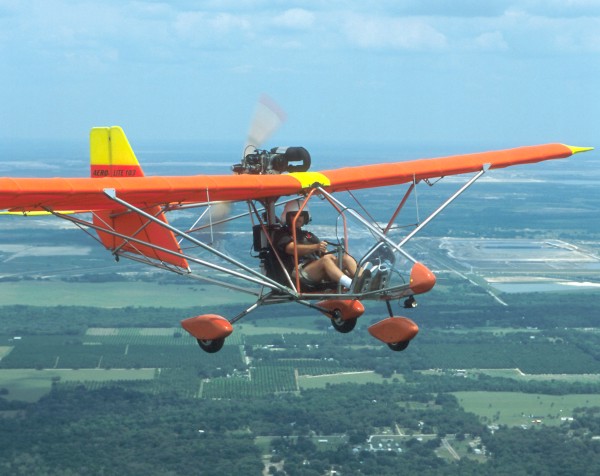
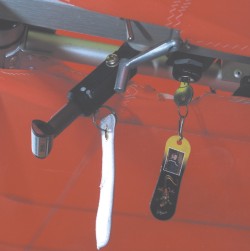
OVERHEAD CONTROLS – Directly above the pilot’s head are some additional controls. Here we see the electric start switch, the cranking flap handle, and the parachute activation handle.
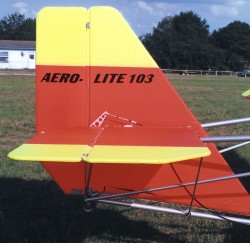
TAIL VOLUME – I’m a believer in big tails; I find aircraft with them fly better. Evidently designer Terry Raber also felt this way as the Aero-Lite 103 has a large vertical area that may account for the model’s quality handling characteristics.
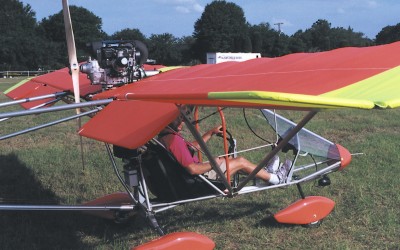
CONTROL DEFLECTION – A full-featured ultralight, the Aero-Lite 103 comes standard with flaps. In this view, Terry Raber shows full flaps contrasted to an upward deflected right aileron.
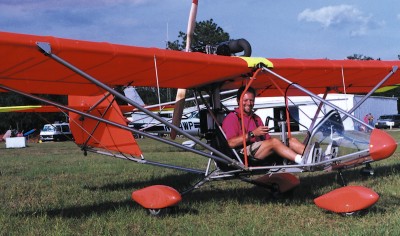
SMILING INVENTOR – Terry Raber no longer runs the company he founded but he remains understandably proud of his ultralight design. He helps with airshow duties and is willing to be the model for the Aero-lite 103.

SECURE SEATING – The Aero-Lite 103’s seat looks much like a Quicksilver seat, except Aero-Works supplies the model with full 4-point seat restraints, which are strongly recommended.

DUAL THROTTLES – One of two Aero-lite 103s on airshow display showed the combination twist-grip throttle and hand brake that the model first used. For those (like me) who prefer a conventional throttle (inset), a lever system with separate brake handle is now standard.
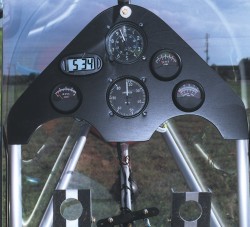
FULL PANEL – With appropriate cutouts for your legs, the Aero-Lite 103 nonetheless offers a panel for all the basic instruments you want in a Part 103 ultralight.
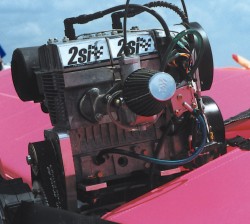
YANKEE POWER – A surer way to stay within the confines of weight for a Part 103 ultralight is to employ the U.S.-based 35-hp 2si 460F-35 twin-cylinder engine. Not only is it lighter, but it runs smoother than I’ve experienced with the 40-hp Rotax 447.
[UPDATE fall 2009 — Aero-Works left the business several years ago (though in late 2009, originator Terry Raber said he will return to production). Meanwhile, producer Wings of Freedom has begun work on the Phoenix-103, a derivation of the Aero-Lite 103 but with numerous small changes.
This article refers to the aircraft built by AeroWorks and will not be identical to the Aero-Lite 103. The companies are different and Terry Raber has no association with Wings of Freedom.
In the uncertain “new world of Sport Pilot,”
one thing remains exactly as it was – FAR Part 103. While new rules and regulations may shake the ground under the feet of ultralight pilots, Aero-Works continues to produce their popular AeroLite 103. If you build it carefully, you can still enjoy a twin-cylinder ultralight with lots of features that fits Part 103.
Even airline pilots who normally fly under smothering regulations appreciate FAA’s simplest, least intrusive rule, Part 103. Many of these jet jockeys turn to ultralights when they want grins in the air.
No “Genuine 103 Ultralights?”
Frankly, I’m tired of hearing it. People at airshows, supposed industry experts, FAA personnel, even people in ultralight aviation businesses say, “Yeah Part 103’s a great rule, but no one makes a Part 103 ultralight.”
Baloney. I own and fly an ultralight that easily fits the rules. And it’s loaded with extras, including electric start. Mine happens to be Cosmos Samba trike, as I’m a soaring enthusiast who wanted a poor-man’s motorglider (which I’m now trading after some years of ownership).
“Oh, well, that’s just a trike,” some reply.
Oh, really? So, a trike isn’t a “real” ultralight? Can’t old joystick fans like me have loads of fun flying such a weight-shift aircraft? Either joystick or control bar flying is a learned response. The only difference is your attitude.
Still, some lament, “Fine, you can fly some trikes and even a few single-place powered parachutes, but there are no 3-axis airplanes that really meet the rule and are powerful enough (or feature laden enough) to be fun for me.”
And again I retort, “Oh yeah? What about|” and I name one of a dozen models that make the grade.
Despite conventional wisdom, pilots actually have a choice of several 3-axis ultralights that are fun to fly and if built carefully can fit Part 103’s toughest requirement, the 254-pound weight limit.
True you can’t load them up with options unless you go the route I did. But some manufacturers have learned to squeeze more and more within Part 103’s 254-pound weight limit (before parachute or floats). One company in particular offers a lot of bang for the buck.
Best of Breed?
Aero-Works Aero-Lite 103 is one of those Part 103 3-axis aircraft. Not only that, it has the engine power to be interesting and it comes with features that are options or unavailable on larger aircraft.
Despite these comments, let me make a disclosure here. I preferred the Aero-Lite 103 with the 46-hp Rotax 503 engine to the 40-hp Rotax 447 version. I’d rather have a 46-hp Rotax even though such a plane won’t make Part 103 (or at least you’d have to be very creative). Even allowing 24 pounds for a parachute, I doubt an Aero-Lite 103 with a Rotax 503 would stay under the then-total 278 pounds total allowed.
Fortunately, my experience with the 2si engines I’ve flown has been very good. While it’s true I usually get to examine nearly new ultralights for these reviews, I have nonetheless had all good experiences with the 35-hp 2si 460F-35 powerplant. Based on that experience, the 2si engine should be a worthy purchase and, most importantly, it offers enough power to generate a thrill while still helping the Aero-Lite 103 stay within the Part 103 weight limits. Contrarily, the 2si engines have never really sparked in a marketplace dominated by Rotax engines. Many pilots like myself are pulling for the 2 Stroke International company, but they have yet to emerge as a truly solid player in this business.
For this report, I flew two versions of Aero-Works single-seater. One had a Rotax and the other had the 2si engine. The other difference of note between the two ultralights is that the Rotax-powered one had the older twist-grip throttle and the 2si model featured the newer lever throttle.
The Aero-Lite 103’s original throttle was a twist-grip style. You twist your hand toward your palm, or toward the cockpit, to increase power. You twist away from the cockpit to reduce power. For pilots familiar with motorcycle-type twist throttles, this method may not be counterintuitive. However, motorcycle throttles aren’t naturally intuitive either, in my opinion. Anyone who has ridden a motorcycle gets used to it rather quickly, but what might seem intuitive rotating the throttle in the direction of desired movement is not what you do.
Therefore, though I acclimated to Aero-Lite 103’s twist-grip throttle, I did not fly it enough for the motion to become mechanical. On landing approach, I tended to move the throttle slightly to be sure I was twisting the right direction. Evidently I wasn’t the only one who didn’t love the throttle action as Aero-Works has now made a lever throttle the standard.
As with all decisions, this was a compromise. Doing away with the twist-grip throttle added another lever in the cockpit. Now positioned in front of the throttle is the brake lever, which you pull back to tighten the brakes on each main wheel.
The twist-grip system was first chosen as one lever could do dual duty. In addition to the throttle control, the lever moved fore and aft to serve as a hand brake. Since you didn’t need to remove your hand from the throttle to start ground braking, you had one less distraction to upset your landing. It was well thought out but still, I don’t care for the twist-grip method.
The reason Aero-Works wanted a separate brake lever rather than using the common squeeze grip on the front of the joystick is because the company also went with a yoke control. As with the twist-grip throttle, designer Terry Raber had a plan for this as well. He wanted to use dual pull/pull linkages to operate the ailerons and elevator. A yoke permitted this more readily than a joystick, he says. Such redundancy in a vital control system is a very worthwhile decision that deserves our appreciation.
In addition to the redundant control linkages, Raber felt that general aviation pilots would more readily adapt to the Aero-Lite 103. Nearly all general aviation planes use yokes instead of joysticks, so those pilots who wanted to transition to ultralights would find a more familiar control system. Further, those who flew in an Aero-Lite 103 for their first experience would theoretically make a smoother transition to a Cessna or Piper for the same reason. It all makes sense. And yet, many ultralight pilots prefer joysticks.
In order to keep weight down, Raber’s design was also carefully crafted to allow the incorporation of flaps. He again did things differently. Flaps on the Aero-Lite 103 are controlled by a hand crank lever above your head. Most ultralights use a lever that you pull up or down to deploy flaps.
With the hand-crank lever, a counterclockwise movement lowers the flaps; clockwise retracts them. This is another of those things you must just remember. Aero-Works isn’t alone in using a crank; they are also common in general aviation aircraft like older Pipers and Champions. However, in those aircraft a large decal or plate usually surrounds the crank, showing you which way to turn the handle.
You must also turn it quite a ways. A number of full turns are required to put the flaps down to their maximum 30° deflection. The crank and gradual application means you have infinitely adjustable flaps. It also means you can’t get them on or off as fast as an ultralight with a lever for flap control. Again, I prefer the lever method, though I agree the crank is small and unobtrusive and the flaps work very well on the Aero-Lite 103.
Folding wings have proven to be a popular option or feature of ultralight aircraft. Many buyers ask if they are available on an ultralight that they are examining. Aero-Lite 103 does not offer folding wings. Instead the company gives this advice: “To fold the wings, you would first need to remove the tail before folding the wings, and this would defeat the purpose [and] convenience of a folding wing. A foldable wing would also add extra weight and complexity to the simple design of the Aerolite. Two people can disassemble the Aero-Lite 103 into four basic components (fuselage, left and right wing panels, and tail section) in 40 to 60 minutes.” While folding wings provide a sales point, I’ve asked many pilots who bought the feature if they use it regularly. Most answer that they rarely fold their wings.
Fresh-Air Cabin
Aero-Works makes no apology for their open cabin. For those in colder climates, the company advises you buy a good cold-weather suit. Modern fabrics have made these less bulky and surprisingly warm. You may be more comfortable in a snowmobile suit than without one in a fully enclosed cabin. Yet some pilots prefer a full enclosure. Those aviators have other machines to choose from but they’ll miss the special charms of an Aero-Lite 103.
For my flying in steamy Florida last April, the openness was perfect. I got no windblast at all being well sheltered by the simple yet effective windscreen, and I loved the flow of air during a warm time of year. My only negative about the front fairing system is that a lack of fuller floor allowed some runway debris to enter the cabin. However, most of it went on my lap and not in my eyes where it might cause a problem.
Entering an open enclosure is also easier though you must wind yourself around Aero-Lite 103’s main cockpit structural tubing. All but very movement-limited pilots will find it no great challenge. However, like so many pusher engine ultralights, the Aero-Lite 103 sits on its tail at rest (on a wheel they provide). When you sit down in it, you should take care not to harshly slap the nosewheel to the ground.
I strongly prefer 4-point seat belts in ultralights and Aero-Works provides them as standard equipment. Note that BRS parachutes require such restraint should you use your emergency system. Since the Aero-Lite 103 is commonly sold with a BRS, the belts make a good combination.
Once seated, I looked around at my surroundings. For me, the throttle was a full arm’s reach to operate it but I have short arms. The panel was also out of reach though I didn’t need to control any of the mounted gauges. If I used an electronic flight instrument, this might present a problem. Countering these placements, I found the flap crank, kill switch, and BRS parachute handle to be easily reached just above and in front of my head.
The Aero-Lite 103’s yoke position was at a comfortable height. Mounted at approximately my knee, I had an armrest while flying but I could therefore bump my knee with the yoke. You can’t have it both ways.
The Ohio company says, “The Aero-Lite 103 will comfortably fit those from 5 feet 3 inches to 6 feet and weighing from 120 to 220 pounds.” For larger pilots they offer a “Tall Man” option that adds 2 inches of extra legroom.
Taxi steering was very precise though the Aero-Lite 103 is lightly loaded on the nosewheel. On some bumpy or undulating runways, this means you may temporarily lose traction at the nosewheel, but I found this to be an infrequent and short-lived problem.
Since designer Terry Raber borrowed from several successful models, and since the Aero-Lite 103 is a very well mannered ultralight, lifting off from and returning to terra firma was not challenging. In fact, I found it a joy. As I also feel about other ultralights, such as the CGS Hawk from which Raber borrowed ideas, takeoffs and landings can be huge fun all by themselves. Only a very inattentive pilot would have trouble with the Aero-Lite 103.
Smooth Flyer
I’ve flown three Aero-Lite 103s and I’ve found the design to be a wonderful flying machine. This is a very nice handling ultralight, both on the ground while taxiing and once I went aloft.
The Aero-Lite 103’s yoke is at a reasonable arm extension. Though I prefer joysticks, I found operating the Aero-Lite 103 via its yoke was simple.
Joysticks overwhelmingly populate the world of ultralights. Besides Aero-Works, Quicksilver uses yokes in their GT series and Golden Circle Air uses yokes for their T-Bird line. “We chose to incorporate a stick/yoke control system to allow us to incorporate the redundancy of the dual stainless steel push/pull cable-operated control surfaces,” says Aero-Works.
Dutch rolls went very well from a coordination standpoint, though I wasn’t able to bank as steeply since the rudder didn’t seem as authoritative as the ailerons. The latter are surprisingly responsive without being too sensitive, but I had to bear down more so on the rudder pedals. Fortunately, my legs are stronger than my arms so this was not an issue.
When I flew in the Aero-Lite 103 with the 46-hp Rotax 503 SC engine, that engine ran somewhat roughly. Aero-Works reports the 35-hp 2si 460F-35 engine is smoother, which has been my experience on several occasions.
In the Rotax Aero-Lite 103 I found that even close to 6,000 rpm, I did not maintain altitude. While possibly operating at a less-than-optimal setting, the power needed to sustain altitude created vibration that could be felt through tubes situated near my body.
Maximum speed was somewhere in the upper 60s and stalls were around 30 mph for a speed envelope of about 2.2 times. This is not an uncommon range for ultralights, which are often open cockpit and rather draggy designs.
Based on testing and experience from factory Aero-Lite 103 ultralights, the company has some general advice about the standard 5 gallons of fuel you can carry under Part 103. “Depending on flight conditions of the day, engine choice and gross weight, the Aerolite at a cruise power setting and 5 gallons of fuel should achieve around 1.5 to 2 hours of flight time, with a range of 80 to 120 miles,” they say.
Ultralight pilots are notorious about asking for all manner and brands of engines. Inreply to these inquiries, Aero-Works is simple and to the point. “The 40-hp Rotax 447 and 46-hp Rotax 503 – both single carb and using the B-model gearbox – and the 35-hp 2si 460F-35 are the only factory-recommended engines at this time,” says the company. The 2si may not be as familiar as Rotax engines, but Aero-Works says it “will give you excellent performance with lighter weight and [lower] cost.”
For those considering float operations, flying from higher elevations or who simply prefer the redundancy of the dual ignition system on the Rotax 503 may also want to consider its use. But Aero-Works cautions, “It is really not necessary to use this larger engine.” They add that the Rotax 503, like other options and accessories, simply adds weight, cost, and complexity to the ultralight. Very likely this engine with the typical selection of options will push you past Part 103’s weight limits.
Buy a Part 103 Ultralight
Only requiring an assembly area the size of a two-car garage, the company says, “The Aerolite assembly kit is 100% complete including everything you need to assemble and fly your Aero-Lite 103 in 60 to 80 hours of assembly time.”
The model is available with either colored Dacron® sails or Superflite aircraft fabric painted with a urethane finish. The Dacron sails require no gluing or painting and are available in several choices of colors. They are much easier to assemble than dope-and-fabric coverings.
Aero-Works says the [Dacron wing and tail] covers should last around 5 to 7 years and possibly longer assuming good care and indoor storage. Of course, locale is also important. If you store your Aero-Lite 103 outside in the elements (especially in sunny southern climates), the Dacron covers may only last 2 to 3 years if unprotected.
In any event, at some point Aero-Lite 103 owners would need to consider new Dacron. Aero-Works reports the average replacement cost for a set of new sails is $1,500 to $1,600. They also wisely add, “You can purchase an inexpensive fabric tester through many of the aircraft supply outlets that will allow you to check the condition of your covers. You should try to check them annually or every 200 hours.”
Some buyers ask, “Can I pick up my Aero-Lite 103 at the factory to save shipping and crating costs?” Aero-Works responds affirmatively, “Yes, in fact we highly recommend this. This will allow us to meet you and ensure that you are receiving an undamaged kit.”
Aero-Works offers 1 hour of factory help to load your kit without a fee and 2 hours for a ready-to-fly Aero-Lite 103 as a courtesy to their customers. However, they will not build or make modifications to your trailer for you to haul your Aerolite. Instead they say, “Come prepared.” To make it easier on those without a trailer to haul their ultralight, Aero-Works will supply information on how you can prepare to carry your kit or ready-to-fly Aero-Lite 103.
I find it delightful that you can choose an Aero-Lite 103 with the standard 2si engine and pay only $9,995 for a complete kit. That’s half the price of the average new car today and a carefully built Aero-Lite 103 can meet the definitions in FAR Part 103.
Those who insist on the 46-hp Rotax 503 engine will pay only $1,000 more, but you’ll need a pilot’s certificate and N-numbers to fly it. If you select the 35-hp 2si engine, or skip options on the Rotax versions, Aero-Works can and will build your Aero-Lite 103 for you. Their price is so reasonable I can hardly imagine anyone building their own. When Aero-Works started 5 years ago, they didn’t even offer kits, fully building all ultralights delivered.
Today, Aero-Works adds only $1,400 to the $9,995 base price of the 2si Aero-Lite 103 to deliver it ready to fly. They’ll even break in the engine and test-fly it for you, weather permitting. The same $1,400 fully built charge applies to the Rotax 447 and Rotax 503 single-carb models, but you’ll need to speak to the company to assure the plane doesn’t fall into the amateur-built category where you must do 51% of the work.
We may be entering the age of “Sport Pilot,” but why bother with all that added complexity when Aero-Works offers such a cool ultralight at such a bargain price? No license, medical, or registration is required. Just add fuel and go have fun.
| Seating | 1 |
| Empty weight | 254 pounds |
| Gross weight | 600 pounds |
| Wingspan | 26 feet 10 inches |
| Wing area | 124 square feet |
| Wing loading | 4.8 pounds per square foot |
| Length | 17 feet |
| Height | 75 inches |
| Kit type | Fully assembled or assembly kit |
| Build time | 60-80 hours |
| Standard engine | 2si 460F-35 |
| Power | 35 hp |
| Power loading | 17.1 pounds per hp |
| Cruise speed | 55-70 mph |
| Never exceed speed | 75 mph |
| Rate of climb at gross | 800 fpm |
| Takeoff distance at gross | 100 feet |
| Landing distance at gross | 200 feet |
| Standard Features | Belt reduction drive, 35-hp 2si 460F-35 engine, 2-blade wood prop, redundant linkages to ailerons and elevator, lever (not twist grip) throttle, nose fairing and windscreen, ASI, nonsensitive altimeter, single EGT, single CHT, tachometer, clock, infinitely adjustable flaps, steerable nosewheel, 4-point seat belts, padded seat, 5-gallon seat tank, presewn Dacron wings and tail. |
| Options | 40-hp Rotax 447 or 46-hp Rotax 503 single-carb engine (all engines use same mount), 2- or 3-blade composite prop, mechanical brakes, wheel pants, additional instruments, fully-assembled option, ballistic emergency parachute. |
| Construction | Aluminum 6061-T6 airframe, 4130 steel components, vacuum-formed plastic nose fairing, formed aluminum wing ribs, sewn Dacron wing coverings. Made in the USA. |
Design
Cosmetic appearance, structural integrity, achievement of design goals, effectiveness of aerodynamics, ergonomics.
Pros – Now-familiar design with changes and improvements to increase appeal. Impressive standard features in a design still qualifying under Part 103. Design has more than 5 years field service with few complaints. Parts of the Terry Raber design (wisely) borrow from other popular ultralights.
Cons – Not all buyers will want the 2si engine needed to stay within Part 103’s tight weight limits. Presently only offered as a single-seater in a world that likes 2-seat ultralights.
Systems
Subsystems available to pilot such as: Flaps; Fuel sources; Electric start; In-air restart; Brakes; Engine controls; Navigations; Radio; (items covered may be optional).
Pros – Well equipped Part 103 ultralight: flaps, brakes, 4-point seat belts. Flaps infinitely adjusted with a hand crank; extend to 30° down. Throttle can be twist grip combined with hand brake or conventional push/pull T-handle; if latter chosen then brake is a separate handle in front of throttle. BRS handle well located.
Cons – Hand-cranked flaps don’t deploy or retract as quickly as lever-controlled surfaces. The 2si engine needed to make Part 103 with few sacrifices is not universally accepted. Brakes are nondifferential. No other negatives.
Cockpit/Cabin
Instrumentation; Ergonomics of controls; Creature comforts; (items covered may be optional).
Pros – Seat comfortable even for large pilots (up to 235 pounds) according to owners. Standard 4-point restraint system. Fuel tank on rear of seat keeps spills from making a mess inside. Open cabin gives the ultralight feel yet the pilot is protected from windblast.
Cons – Not well protected for very cold climates; requires cold-weather suit. Entry around a few tubes may be challenging for disadvantaged pilots. Reach to instrument panel is beyond most pilots’ arms. Minimal radio space. Some debris can fly into the cockpit from front wheel.
Ground Handling
Taxi visibility; Steering; Turn radius; Shock absorption; Stance/Stability; Braking.
Pros – Responsive nosewheel steering. Mainwheel brakes help ground handling especially on hard surfaces. Brakes showed good effectiveness. Turn diameter was fairing tight. Several inches of ground clearance help on unimproved fields. Six-inch wheels roll well over rough ground.
Cons – Sitting under the wing restricts upward visibility for prelaunch traffic checks. Sits on tail when not occupied (like many ultralights). No easy seat adjustment. Lightly loaded on the nose; reduces steering traction in some situations. Shock absorption is limited to gear leg flex and air in the tires.
Takeoff/Landing
Qualities; Efficiency; Ease; Comparative values.
Pros – Crosswind conditions presented little problems for me. Twin cylinder power makes for short takeoff rolls. Wide main gear stance. Rotate at 40 mph; approach at 40 to 50, both are slow speeds typical of Part 103 ultralights. Brisk climb on any engine choice. Short ground roll on landing.
Cons – Because of limited side area, slips won’t be particularly useful (though potent flaps give you adequate landing control). Loses energy quickly (like many ultralights); you should retain extra speed to assure control authority. No other negatives discovered.
Control
Quality and quantity for: Coordination; Authority; Pressures; Response; and Coupling.
Pros – Quite responsive controls without any hint of touchiness; light and predictable feel. Roll is about 2.5 seconds 45°-to-45° (faster than many ultralights). Precision turns were confidence inspiring. My Dutch roll coordination exercises went well to mild angles thanks to responsive ailerons.
Cons – Older knob input for flaps has been improved with the crank handle but is still slower to deploy than a lever control. Twist-grip throttle offered on some models is unintuitive. No other control negatives discovered.
Performance
Climb; Glide; Sink; Cruise/stall/max speeds; Endurance; Range; Maneuverability.
Pros – Keeping the Aero-Lite 103 light makes 35 hp more than adequate; also helps keep sink rate low. Performs almost identically with Part 103 rules. Cruise speeds were comfortable around 50 mph. Climb averaged 800 fpm. In my low-over-the-fields flying, the Aero-Lite 103 did beautifully.
Cons – To stay within Part 103’s 63-mph speed limit, Aero-Lite 103 can’t be and isn’t very speedy (but it flies so nicely, who cares?). Fuel endurance isn’t great, the same as many other semi-open ultralights. Also took a higher percentage of power to stay level than a more enclosed ultralight.
Stability
Stall recovery and characteristics; Dampening; Spiral stability; Adverse yaw qualities.
Pros – Stalls in all attitudes were quite benign; no evil tendencies noted in any stall. Speeds showed mid-20s mph and felt as slow as that sounds. Adverse yaw was very mild. Push- or pull-and-release checks were positive, showing good longitudinal stability. BRS parachute was appreciated.
Cons – You have to push hard to get a stall to break, but then it will. Power setting had to be raised in steep turns (though this is common). High thrust line pushes the nose down as you’d expect.
Overall
Addresses the questions: “Will a buyer get what he/she expects to buy, and did the designer/builder achieve the chosen goal?”
Pros – The Aero-Lite 103 has proven to be a successful design showing that Part 103 ultralights are available and do sell. Excellent value with several normally optional items included as standard. Company is now 5 years old and seems to be in good shape (they say 2001 was a strong year). No complaints from owners have been voiced to me.
Cons – Some pilots just don’t buy single-seaters; may limit resale value. Breakdown is rather laborious with no folding wing option coming. If you want a fast cross-country cruiser, this isn’t it. Lack of full enclosure will turn off some cold-climate buyers. Few overall negatives to report.


Hello, I am trying to find the gross weigh & empty weigh of a 2001 Areolite 103 with a 35 hp 2si engine? ( It has a gas tank seat & no electric start or battery ) Thanks, Bud
I recommend you contact the factory (). The 2si engine is now quite old and U-Fly-It has only owned the design for a few years so they may not have that information. However, they will surely try to help.